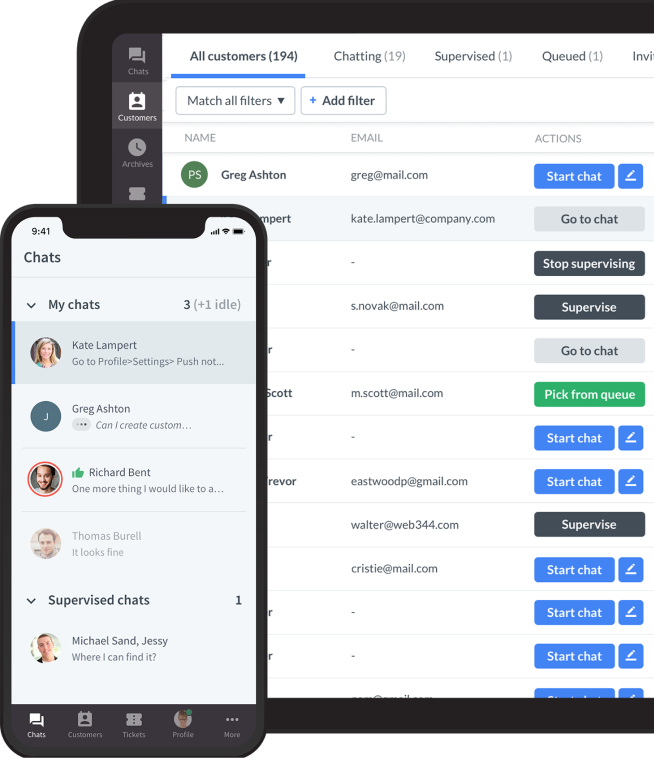
TL;DR: Customer service automation takes repetitive work off your team’s plate — routing tickets, answering FAQs, resolving tasks — so agents focus on what matters most. The real win? Happier customers, without burning out your team.
***
It’s midnight. A customer opens your chat window to request a return. Normally, they’d wait until morning for a reply. But with customer service automation, the system checks the order, pulls the return policy, and issues a label instantly.
No agent, no delay.
That’s the promise of automation: letting AI handle the repetitive work so your team can focus on conversations that actually need a human touch.
Why this matters now
That midnight return? It isn’t rare anymore. Customers expect answers on their time, not yours. If they don’t get them, they move on.
The volume of requests is only going up — spanning chat, email, social, and more. Teams are stretched thin, bouncing between tabs, chasing down lost tickets, and firefighting delays. Burnout becomes the norm.
This is where automation earns its place. By taking care of the repetitive, it buys your team the capacity to stay human where it counts: complex issues, nuanced conversations, and moments where empathy — not speed — wins loyalty.
What customer service automation actually means
When people hear “automation,” they often picture clunky chatbots from a decade ago. That’s not it.
Customer service automation is everything that helps support run on autopilot without losing the human touch. It’s the invisible hand routing tickets to the right person. It’s the AI agent that can answer a shipping question at 2:00 AM. It’s the self-service portal that lets a customer reset their password in seconds instead of waiting in a queue.
Think of it like air traffic control for your support requests. The planes (questions) still need pilots (agents), but automation directs the flow so nothing collides, nothing gets lost, and everything lands smoothly.
Core types of automation in customer service
Automation shows up in different shapes, but most of it falls into a few buckets:
-
Ticketing and routing. Instead of a manager triaging emails one by one, automation tags and assigns them instantly. A billing question goes to finance, a technical bug to support. Nothing slips through the cracks.
-
AI chat and virtual agents. These are the digital coworkers who handle FAQs and repetitive tasks. “Where’s my order?” “How do I reset my password?” They answer in seconds, 24/7, and know when to hand off to a human.
-
Self-service. Think searchable knowledge bases, guided workflows, or AI-powered FAQs. Customers get answers without starting a conversation at all.
-
Proactive support. Automation isn’t just reactive. It can send reminders, update delivery statuses, or follow up after an issue is resolved — closing the loop without manual effort.
The goal isn’t to replace your team. It’s to clear the runway so agents spend less time copy-pasting responses and more time solving problems that actually need them.
Common fears (and what they get wrong)
Whenever automation comes up, the same worries surface.
“It’ll feel robotic”
Most of us remember the chatbots that answered everything with “I don’t understand.” No wonder automation has a bad reputation. But today’s AI is trained on your company’s actual knowledge base and customer data. That means responses aren’t generic — they’re context-aware and often indistinguishable from a human reply. And when nuance is needed, automation hands the conversation to a person, gracefully.
“We’ll lose control”
Handing conversations over to a system sounds risky. But automation isn’t a black box — it’s rule-based, customizable, and auditable. You decide what gets automated and when. If you want returns automated but VIP accounts escalated to humans, you can set that up. The result is more visibility and consistency, not less.
“It’s too complex to implement”
This was true when automation meant months of IT projects and costly consultants. Now, tools like Text App make it as simple as toggling workflows on or off. You can start by auto-tagging tickets or setting up canned responses. No coding, no endless setup — just gradual layers of automation that grow with your team.
The fears come from an older era of support. Modern automation is designed to empower teams, not replace them. What once felt like a clunky add-on is now built to blend seamlessly into how teams already work.
Where Text App fits in
If customer service automation is the concept, Text App is the execution. It’s an AI customer service tool where live chat, email tickets, and AI-powered agents all flow together.
What makes it different is the AI-first design. Many tools bolt on a chatbot as an afterthought. Text App was built around automation from day one. Its virtual agents don’t just answer FAQs — they resolve real issues, like issuing a return label or updating an order, and know exactly when to escalate to a human.
And because it’s omnichannel, your team doesn’t have to juggle separate systems. A customer might start with a Messenger message, continue by email, and end on your website chat—all in one continuous thread inside Text App.
That balance is the point. Customers get speed and consistency, while your team gets focus and control.
Checklist for getting started
You don’t need to automate everything at once. Start small, prove value, then scale. Here’s a simple framework:
-
Identify pain points. Where are customers waiting the longest? Which questions come up 100 times a week? Start there.
-
Train on your own data. The best automation learns from your knowledge base and past tickets — not from generic scripts.
-
Begin with quick wins. Auto-tagging tickets, routing simple inquiries, or answering FAQs are low-risk, high-reward.
-
Define escalation paths. Make sure customers can always reach a human when they need to. Automation should feel like a safety net, not a wall.
-
Measure results. Track response times, customer satisfaction, and ticket resolution rates. Use the data to decide what to automate next.
Think of it as layering. Each small step frees more time for your team, until automation becomes the quiet backbone of your support operation.
You know automation is working when the midnight return request isn’t an exception — it’s just how things run. Customers get what they need without waiting.
On the inside, your team feels the shift too:
-
Response times shrink without extra headcount.
-
Agents focus on complex cases instead of copy-pasting answers.
-
Burnout drops, because repetitive tasks don’t pile up.
-
Leaders see higher CSAT scores and a support operation that finally scales.
The biggest change is subtle but powerful. Support stops being a constant firefight. Instead, it becomes a reliable system where AI handles the routine, and humans handle what humans do best — listening, empathizing, and solving the problems that can’t be scripted.
Conclusion
That midnight return request? It’s no longer a support nightmare — it’s a solved problem. That’s the promise of customer service automation: fewer delays, less stress, and more meaningful work for your team.
Automation doesn’t replace empathy; it protects it. By offloading the repetitive, your agents can focus on the conversations that actually build loyalty.
If you’re ready to see what this looks like in practice, try the Text App. Start free today and discover how AI-driven automation can turn your support from reactive firefighting into a system that simply works.
Curious how this works in practice? Start your free Text App’s trial now.
FAQ
What is customer service automation?
It’s the use of software, workflows, and AI agents to handle routine support tasks — like ticket routing, FAQs, and returns — so your team can focus on complex issues.
Is automation the same as chatbots?
Not exactly. Chatbots are one form of automation, but modern automation goes further: ticket management, proactive updates, knowledge base search, and AI-driven task completion.
Does automation replace human agents?
No. The best systems are designed to complement agents, not replace them. Automation handles repetitive work, while humans step in for nuance, empathy, and problem-solving.
Is customer service automation only for big companies?
Not anymore. Tools like Text App make it easy for small teams to start small — say, auto-tagging or answering FAQs — and scale up as they grow.
How do I measure success?
Track key metrics like response time, customer satisfaction (CSAT), and resolution rates. If those improve without adding more headcount, your automation is doing its job.



